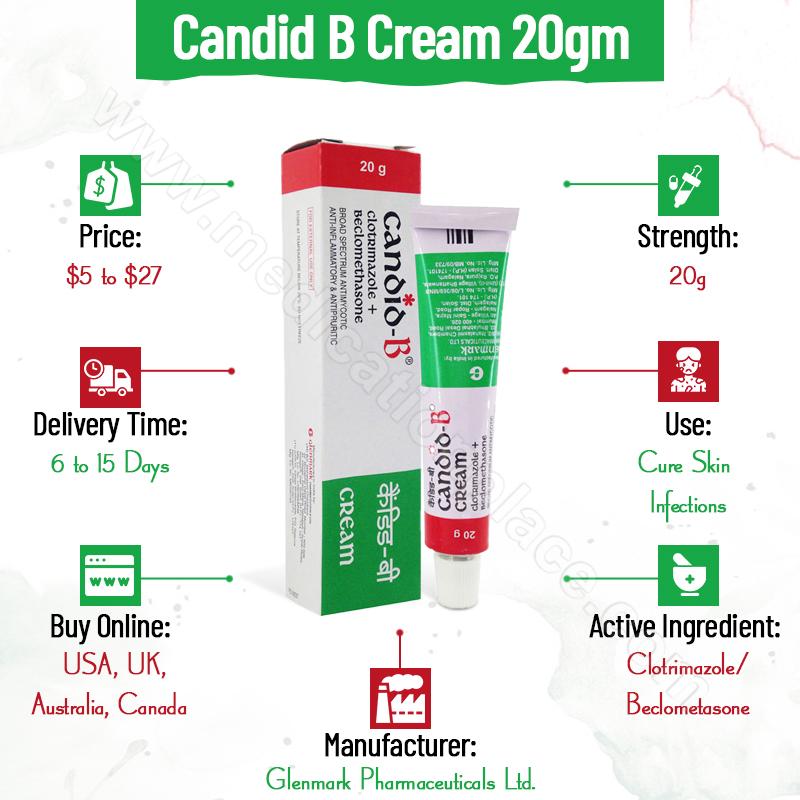What is Candid B Cream 20gm?

Candid B Cream is a topical medication that is primarily used to treat various skin conditions, particularly fungal infections. The cream contains two active ingredients: clotrimazole and beclomethasone. Clotrimazole is an antifungal agent, while beclomethasone is a corticosteroid with anti-inflammatory properties.
This combination makes Candid B Cream effective in relieving symptoms associated with fungal infections, such as itching, redness, inflammation, and discomfort.
Fungal infections are common and can affect different parts of the body, including the skin, nails, and mucous membranes. Candid B Cream is typically prescribed for conditions like athlete's foot, jock itch, ringworm, and yeast infections. It works by inhibiting the growth of fungi, thus helping to eliminate the infection.
Clotrimazole, one of the active ingredients in candid b cream 20gm, belongs to the azole class of antifungal drugs. It works by disrupting the synthesis of ergosterol, an essential component of the fungal cell membrane.
By inhibiting the production of ergosterol, clotrimazole weakens the fungal cell membrane, leading to its death. This action effectively combats the fungal infection and helps alleviate the associated symptoms.
Beclomethasone, the other active ingredient in Candid B Cream, is a corticosteroid that possesses anti-inflammatory properties. It helps reduce inflammation, redness, and swelling associated with fungal infections.
Beclomethasone works by suppressing the release of inflammatory mediators and inhibiting the migration of immune cells to the affected area. This action helps relieve the discomfort and itching caused by the infection.
When applying Candid B Cream, it is important to follow the instructions provided by the healthcare professional or the product label. Generally, a thin layer of the cream should be applied to the affected area and gently rubbed in.
The cream is usually applied two to three times a day, or as directed by the healthcare professional. It is crucial to clean and dry the affected area before applying the cream to ensure maximum effectiveness.
Although Candid B Cream is generally safe and well-tolerated, it may cause some side effects in certain individuals. Common side effects include itching, burning, stinging, redness, or irritation at the application site.
These side effects are usually mild and temporary. However, if any severe or persistent side effects occur, it is important to seek medical attention.
Candid B Cream is contraindicated in individuals with known hypersensitivity to clotrimazole, beclomethasone, or any other components of the cream. It should not be used in patients with viral or bacterial skin infections, acne, rosacea, or perioral dermatitis. Additionally, it should not be applied to the eyes, mouth, or genital area unless specifically instructed by a healthcare professional.
As with any medication, Candid B Cream may interact with other drugs. It is important to inform the healthcare professional about any other medications, including over-the-counter drugs and herbal supplements, being taken concurrently. They can provide guidance on potential interactions and ensure the safe and effective use of the cream.
In conclusion, Candid B Cream is a topical medication used to treat fungal infections of the skin. It combines the antifungal agent clotrimazole with the corticosteroid beclomethasone to provide relief from symptoms such as itching, redness, and inflammation.
By inhibiting fungal growth and reducing inflammation, Candid B Cream effectively combats fungal infections and promotes healing. However, it is essential to use the cream as directed and consult a healthcare professional if any concerns or adverse reactions arise during its use. Visit medicationplace pharmacy site for more details.
- Art
- Causes
- Crafts
- Dance
- Drinks
- Film
- Fitness
- Food
- Oyunlar
- Gardening
- Health
- Home
- Literature
- Music
- Networking
- Other
- Party
- Religion
- Shopping
- Sports
- Theater
- Wellness


